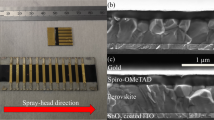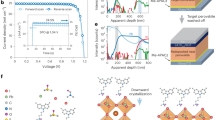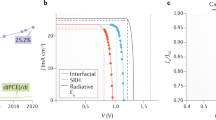Abstract
One potential advantage of perovskite solar cells (PSCs) is the ability to solution process the precursors and deposit films from solution1,2. At present, spin coating, blade coating, spray coating, inkjet printing and slot-die printing have been investigated to deposit hybrid perovskite thin films3,4,5,6. Here we expand the range of deposition methods to include screen-printing, enabled by a stable and viscosity-adjustable (40–44,000 cP) perovskite ink made from a methylammonium acetate ionic liquid solvent. We demonstrate control over perovskite thin-film thickness (from about 120 nm to about 1,200 nm), area (from 0.5 × 0.5 cm2 to 5 × 5 cm2) and patterning on different substrates. Printing rates in excess of 20 cm s−1 and close to 100% ink use were achieved. Using this deposition method in ambient air and regardless of humidity, we obtained the best efficiencies of 20.52% (0.05 cm2) and 18.12% (1 cm2) compared with 20.13% and 12.52%, respectively, for the spin-coated thin films in normal devices with thermally evaporated metal electrodes. Most notably, fully screen-printing devices with a single machine in ambient air have been successfully explored. The corresponding photovoltaic cells exhibit high efficiencies of 14.98%, 13.53% and 11.80% on 0.05-cm2, 1.00-cm2 and 16.37-cm2 (small-module) areas, respectively, along with 96.75% of the initial efficiency retained over 300 h of operation at maximum power point.
This is a preview of subscription content, access via your institution
Access options
Access Nature and 54 other Nature Portfolio journals
Get Nature+, our best-value online-access subscription
$29.99 / 30 days
cancel any time
Subscribe to this journal
Receive 51 print issues and online access
$199.00 per year
only $3.90 per issue
Buy this article
- Purchase on Springer Link
- Instant access to full article PDF
Prices may be subject to local taxes which are calculated during checkout




Similar content being viewed by others
Data availability
The data that support the findings of this study are available from the corresponding authors on reasonable request. Source data are provided with this paper.
References
Correa-Baena, J.-P. et al. Promises and challenges of perovskite solar cells. Science 358, 739–744 (2017).
Han, G. S. et al. Spin-coating process for 10 cm × 10 cm perovskite solar modules enabled by self-assembly of SnO2 nanocolloids. ACS Energy Lett. 4, 1845–1851 (2019).
Zeng, L. et al. Controlling the crystallization dynamics of photovoltaic perovskite layers on larger-area coatings. Energy Environ. Sci. 13, 4666–4690 (2020).
Jeong, D.-N. et al. Perovskite cluster-containing solution for scalable D-bar coating toward high-throughput perovskite solar cells. ACS Energy Lett. 4, 1189–1195 (2019).
Xu, M. et al. Efficient triple-mesoscopic perovskite solar mini-modules fabricated with slot-die coating. Nano Energy 74, 104842 (2020).
Mei, A. et al. A hole-conductor–free, fully printable mesoscopic perovskite solar cell with high stability. Science 345, 295–298 (2014).
Shi, L. et al. In situ inkjet printing strategy for fabricating perovskite quantum dot patterns. Adv. Funct. Mater. 29, 1903648 (2019).
Hu, Y. et al. Improved performance of printable perovskite solar cells with bifunctional conjugated organic molecule. Adv. Mater. 30, 1705786 (2018).
Ryu, J. et al. Paintable carbon-based perovskite solar cells with engineered perovskite/carbon interface using carbon nanotubes dripping method. Small 13, 1701225 (2017).
Arora, N. et al. Low-cost and highly efficient carbon-based perovskite solar cells exhibiting excellent long-term operational and UV stability. Small 15, 1904746 (2019).
Hyun, W. J., Secor, E. B., Hersam, M. C., Frisbie, C. D. & Francis, L. F. High-resolution patterning of graphene by screen printing with a silicon stencil for highly flexible printed electronics. Adv. Mater. 27, 109–115 (2015).
Liang, J., Tong, K. & Pei, Q. A water-based silver-nanowire screen-print ink for the fabrication of stretchable conductors and wearable thin-film transistors. Adv. Mater. 28, 5986–5996 (2016).
Zavanelli, N. & Yeo, W.-H. Advances in screen printing of conductive nanomaterials for stretchable electronics. ACS Omega 6, 9344–9351 (2021).
Cheng, Y.-B., Pascoe, A., Huang, F. & Peng, Y. Print flexible solar cells. Nature 539, 488–489 (2016).
Binyamin, T. & Etgar, L. Ways to improve the performance of triple-mesoscopic hole-conductor-free perovskite-based solar cells. Sol. RRL 6, 2200295 (2022).
Li, D. et al. A review on scaling up perovskite solar cells. Adv. Funct. Mater. 31, 2008621 (2021).
Wang, K. et al. Wettability-guided screen printing of perovskite microlaser arrays for current-driven displays. Adv. Mater. 32, 2001999 (2020).
Sulpizio, J. A. et al. Visualizing Poiseuille flow of hydrodynamic electrons. Nature 576, 75–79 (2019).
Liu, K. et al. Zwitterionic-surfactant-assisted room-temperature coating of efficient perovskite solar cells. Joule 4, 2404–2425 (2020).
Li, N., Niu, X., Chen, Q. & Zhou, H. Towards commercialization: the operational stability of perovskite solar cells. Chem. Soc. Rev. 49, 8235–8286 (2020).
Howard, I. A. et al. Coated and printed perovskites for photovoltaic applications. Adv. Mater. 31, 1806702 (2019).
He, M. et al. Meniscus-assisted solution printing of large-grained perovskite films for high-efficiency solar cells. Nat. Commun. 8, 16045 (2017).
Nordness, O. & Brennecke, J. F. Ion dissociation in ionic liquids and ionic liquid solutions. Chem. Rev. 120, 12873–12902 (2020).
Liang, C. et al. Two-dimensional Ruddlesden–Popper layered perovskite solar cells based on phase-pure thin films. Nat. Energy 6, 38–45 (2021).
Hui, W. et al. Stabilizing black-phase formamidinium perovskite formation at room temperature and high humidity. Science 371, 1359–1364 (2021).
Wang, X. et al. Perovskite solution aging: what happened and how to inhibit? Chem 6, 1369–1378 (2020).
Chao, L. et al. Origin of high efficiency and long-term stability in ionic liquid perovskite photovoltaic. Research 2020, 2616345 (2020).
Li, J. et al. Highly efficient thermally co-evaporated perovskite solar cells and mini-modules. Joule 4, 1035–1053 (2020).
Ren, A. et al. Efficient perovskite solar modules with minimized nonradiative recombination and local carrier transport losses. Joule 4, 1263–1277 (2020).
Wan, Z. et al. Screen printing process control for coating high throughput titanium dioxide films toward printable mesoscopic perovskite solar cells. Front. Optoelectron. 12, 344–351 (2019).
Mei, A. et al. Stabilizing perovskite solar cells to IEC61215:2016 standards with over 9,000-h operational tracking. Joule 4, 2646–2660 (2020).
Li, X. et al. A vacuum flash–assisted solution process for high-efficiency large-area perovskite solar cells. Science 353, 58–62 (2016).
Li, Z. et al. Scalable fabrication of perovskite solar cells. Nat. Rev. Mater. 3, 18017 (2018).
Chen, H. et al. A solvent- and vacuum-free route to large-area perovskite films for efficient solar modules. Nature 550, 92–95 (2017).
Li, D. et al. In situ interface engineering for highly efficient electron-transport-layer-free perovskite solar cells. Nano Lett. 20, 5799–5806 (2020).
Jeong, J. et al. Pseudo-halide anion engineering for α-FAPbI3 perovskite solar cells. Nature 592, 381–385 (2021).
Wu, J. et al. Highly orientational order perovskite induced by in situ-generated 1D perovskitoid for efficient and stable printable photovoltaics. Small 18, 2200130 (2022).
Kim, Y. D. & Hone, J. Screen printing of 2D semiconductors. Nature 544, 167–168 (2017).
Huang, F., Li, M., Siffalovic, P., Cao, G. & Tian, J. From scalable solution fabrication of perovskite films towards commercialization of solar cells. Energy Environ. Sci. 12, 518–549 (2019).
Arapov, K. et al. Conductive screen printing inks by gelation of graphene dispersions. Adv. Funct. Mater. 26, 586–593 (2016).
Acknowledgements
This work was financially supported by the Natural Science Foundation of China (grant no. 51972172), the Natural Science Foundation of Jiangsu Province for Distinguished Young Scholars, China (grant no. BK20200034), the Jiangsu Provincial Departments of Science and Technology (grant no. BE2022023 and BK20220010), the Innovation Project of Optics Valley Laboratory (grant no. OVL2021BG006), the Open Project Program of Wuhan National Laboratory for Optoelectronics (2021WNLOKF003), Projects of International Cooperation and Exchanges NSFC (51811530018), the Young 1000 Talents Global Recruitment Program of China, Innovation Foundation for Doctor Dissertation of Northwestern Polytechnical University (CX2021041), the Natural Science Basic Research Plan in Shaanxi Province of China (2021JLM-43) and the Joint Research Funds of Department of Science & Technology of Shaanxi Province and Northwestern Polytechnical University (2020GXLH-Z-007 and 2020GXLH-Z-014).
Author information
Authors and Affiliations
Contributions
Y.C. conceptualized the idea and designed the experiments. Y.C. and W.H. supervised the work. C.C., J.C., H.H. and L.C. carried out the device fabrication and characterizations. J.H., T.N. and H.D. also contributed to device fabrication. J.C., H.H., L.C. and T.N. conducted the optical spectra measurements. H.D. and T.N. synthesized the screen-printing perovskite ink. C.C. and J.C. carried out the SEM and AFM measurements. J.H. and T.N. conducted the viscosity measurements and analysed the data. C.C., J.C., H.H. and L.C. wrote the first draft of the manuscript. Y.C., Y.X., S.Y. and W.H. participated in data analysis and provided major revisions. All authors discussed the results and commented on the manuscript.
Corresponding authors
Ethics declarations
Competing interests
The authors declare no competing interests.
Peer review
Peer review information
Nature thanks Trystan Watson, Baomin Xu and the other, anonymous, reviewer(s) for their contribution to the peer review of this work.
Additional information
Publisher’s note Springer Nature remains neutral with regard to jurisdictional claims in published maps and institutional affiliations.
Extended data figures and tables
Extended Data Fig. 1 Schematic showing different stages of perovskite film screen-printing38.
This process was first proposed by Abbott et al. The ink-transfer process can be divided into six steps. (i) The perovskite ink is flooded into the mesh and spread on the squeegee surface. (ii–iv) The printing mesh comes into contact with the base layer owing to the downward pressure of the squeegee blade. The perovskite ink contacts with the scraper–mesh–base layer composite system. (v) When the scraper is lifted vertically, the printing pressure disappears immediately. The perovskite ink is completely transferred to the substrate, and the mesh and perovskite ink gradually separate. (vi) The perovskite ink is entirely snapped off and spread on the base layer.
Extended Data Fig. 2 The force analysis of fabricating perovskite wet film by different methods39.
a, Screen-printing. b, Inkjet printing. c, Blade coating. d, Slot-die coating. e, D-bar coating. f, Spin coating. The blue arrow indicates the direction of apparatus movement and the green arrow represents the direction of perovskite ink deposition. The θ between the two arrows is 0° for inkjet printing, blade coating, slot-die coating and D-bar coating. The surface spread of the spin-coating method causes the θ of the two arrows to remain invariant. The θ of the screen-printing method can transform arbitrarily in the range 0–180°.
Extended Data Fig. 3 Surface SEM images of perovskite films fabricated by screen-printing with different ink viscosities.
a, 1,330 cP. b, 606 cP. c, 310 cP. d, 176 cP. e, 103 cP. f, 66 cP. g, 50 cP. The data of viscosity were constantly measured with a rotational rheometer from 60 °C to 0 °C at a decrease rate of 3 °C min−1. The 400 mg ml−1 inks at the different ambient temperatures (the integral multiple of 10 °C) were selected to prepare the perovskite thin films and the surface morphologies were subsequently investigated.
Extended Data Fig. 4 Representative cross-sectional SEM images of screen-printed films with various concentrations.
a, 100 mg ml−1. b, 200 mg ml−1. c, 300 mg ml−1. d, 400 mg ml−1. e, 500 mg ml−1. f, The distribution of thickness. Yellow line, measured average thickness of perovskite thin films at different concentrations. Blue line, theoretical thickness of perovskite thin films independent of viscosity change at different concentrations.
Extended Data Fig. 5 The influence of independent printing parameters on the thickness of deposited perovskite films fabricated by the screen-printing method.
a, Printing speed: 2.5 cm s−1, 5 cm s−1, 10 cm s−1, 20 cm s−1, 40 cm s−1. b, Printing gap: 0.3 mm, 0.4 mm, 0.5 mm, 0.6 mm, 0.7 mm. c, Printing pressure: 0.25 MPa, 0.30 MPa, 0.35 MPa, 0.40 MPa, 0.45 MPa. d, Substrate temperature: 20 °C, 30 °C, 40 °C, 50 °C, 60 °C. e, Mesh count: 150, 250, 325, 400, 500. Although we explored the effect of a single parameter on film quality, the remaining printing parameters were fixed (printing parameters are: printing speed: 15 cm s−1, printing gap: 0.6 mm, printing pressure: 0.30 MPa, substrate temperature: 30 °C, mesh count: 325). Moreover, the printing speed is the rate at which the squeegee blade moves across the squeegeeing area when transferring the perovskite ink; the printing gap is the distance between the printing side and the substrate before exerting pressure by the squeegee blade; the printing pressure is the relative force exerted by the squeegee blade on the screen mesh, and the value is the total pressure minus the back pressure; the substrate temperature refers to the surface temperature of the substrate during the screen-printing process. Mesh count is the number of mesh holes per inch.
Extended Data Fig. 6 Influence of independent printing parameters on the roughness of screen-printed perovskite films40.
a, Printing speed: 2.5 cm s−1, 5 cm s−1, 10 cm s−1, 20 cm s−1, 40 cm s−1. b, Printing gap: 0.3 mm, 0.4 mm, 0.5 mm, 0.6 mm, 0.7 mm. c, Printing pressure: 0.25 MPa, 0.30 MPa, 0.35 MPa, 0.40 MPa, 0.45 MPa. d, Substrate temperature: 20 °C, 30 °C, 40 °C, 50 °C, 60 °C. e, Mesh count: 150, 250, 325, 400, 500. f, Typical AFM images of perovskite thin films fabricated by the screen-printing method under optimal conditions of each parameter.
Extended Data Fig. 7 Effect of viscosity on perovskite device efficiency.
Statistical distribution of 56 devices fabricated by the screen-printing method with different ink viscosities. We fabricated devices with an area of 0.05 cm2, and the best PCE obtained was 20.18%. The corresponding viscosity occurred at room temperature (20 °C, 310 cP) and high humidity (relative humidity > 70%). Printing parameters are: printing speed: 15 cm s−1, printing gap: 0.6 mm, printing pressure: 0.30 MPa, substrate temperature: 30 °C, mesh count: 325.
Extended Data Fig. 8 Influence of independent printing parameters on the PCE of screen-printed perovskite films.
a, Printing speed: 2.5 cm s−1, 5 cm s−1, 10 cm s−1, 20 cm s−1, 40 cm s−1. b, Printing gap: 0.3 mm, 0.4 mm, 0.5 mm, 0.6 mm, 0.7 mm. c, Printing pressure: 0.25 MPa, 0.30 MPa, 0.35 MPa, 0.40 MPa, 0.45 MPa. d, Substrate temperature: 20 °C, 30 °C, 40 °C, 50 °C, 60 °C. e, Mesh count: 150, 250, 325, 400, 500.
Extended Data Fig. 9 Performance of perovskite devices with perovskite ink stored in a refrigerator for 0 and 90 days.
The perovskite ink was first used to prepare the screen-printing perovskite films and devices on day 0, and the ink was sealed and stored at 0 °C. After three months, we used the remaining ink to fabricate the thin films and devices, again under the same printing parameters in ambient air. The best PCE of devices with an area of 0.05 cm2 were 20.51% and 20.35% for 0 and 90 days, respectively.
Extended Data Fig. 10 Long-term stability of unencapsulated devices stored in a N2-filled glovebox by screen-printing and spin-coating methods.
Evolution of perovskite devices performance recorded with an active area 0.05 cm2 during the ageing process. The screen-printed photovoltaic devices were tested for 4,000 h, whereas the spin-coated devices were tested for 1,000 h.
Supplementary information
Supplementary Information
This file includes Supplementary Figs. 1–14, Supplementary Tables 1 and 2 and legends for Supplementary Videos 1–5.
Supplementary Video 1
Screen-printing small-area perovskite thin films. Fabricating small-area (1.5 × 2.5 cm2) perovskite thin films by screen-printing at a relative humidity of 20–80% in ambient air.
Supplementary Video 2
Screen-printing large-area perovskite thin films. Fabricating large-area (5 × 5 cm2) perovskite thin films by screen-printing at a relative humidity of 20–80% in ambient air.
Supplementary Video 3
The high viscosity of perovskite ink. High-viscosity characteristics of perovskite screen-printing ink at room temperature.
Supplementary Video 4
Continuous screen-printing of perovskite thin films. Continuous fabrication of perovskite films at a rate of more than 20 cm s−1.
Supplementary Video 5
Thermal annealing of perovskite thin films. Thermal annealing process of small-area (1.5 × 2.5 cm2) and large-area (5 × 5 cm2) perovskite thin films.
Rights and permissions
Springer Nature or its licensor (e.g. a society or other partner) holds exclusive rights to this article under a publishing agreement with the author(s) or other rightsholder(s); author self-archiving of the accepted manuscript version of this article is solely governed by the terms of such publishing agreement and applicable law.
About this article
Cite this article
Chen, C., Chen, J., Han, H. et al. Perovskite solar cells based on screen-printed thin films. Nature 612, 266–271 (2022). https://doi.org/10.1038/s41586-022-05346-0
Received:
Accepted:
Published:
Issue Date:
DOI: https://doi.org/10.1038/s41586-022-05346-0
This article is cited by
-
Resolving electron and hole transport properties in semiconductor materials by constant light-induced magneto transport
Nature Communications (2024)
-
Multifunctional entinostat enhances the mechanical robustness and efficiency of flexible perovskite solar cells and minimodules
Nature Photonics (2024)
-
Enhancing uniformity in large-area slot die coating of low-viscosity perovskite ink
Journal of Coatings Technology and Research (2024)
Comments
By submitting a comment you agree to abide by our Terms and Community Guidelines. If you find something abusive or that does not comply with our terms or guidelines please flag it as inappropriate.



